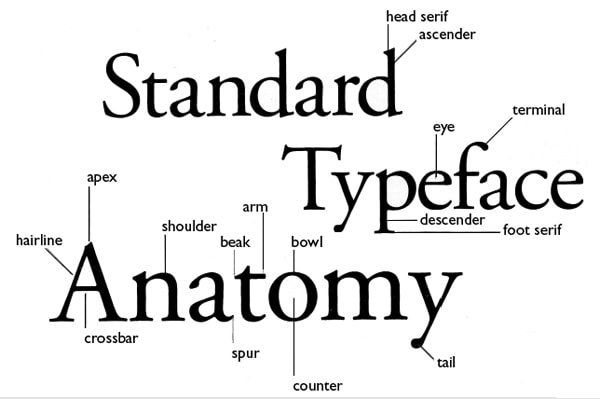ANATOMY OF TYPE
The basic typographic element is called a character, which is any individual letter, numeral, or punctuation mark. The capital letters are called caps, or uppercase characters. Small letters are called lowercase characters. Numbers are called numerals or figures.
Within a given typeface each character will have distinctive similarities which define the typeface and give it it‘s individual style.
The distinctions in each character can be described using the terminology/vocabulary of typographic anatomy. Each of the following tables show a different area of the character.
The term uppercase is a vestige of the days when typesetters separated capital letters in a box above the lowercase letters. It can also refer to any character which is accessed with the shift key on a manual typewriter.
1. Baseline Majority of the characters sit on this imaginary horizontal line. 2. Cap height 3. Crossbar 4. Serif It is the name assigned to the finishing strokes at the tops and bottoms of some typefaces. There is a lot to discuss serifs when we would learn about typeface distinctions. 5. Mean line 6. Bowl 7. Descender Descender happens to be the bottom part of the lowercase letter (like “g”, “j”, “p”, “q”, “y” etc) that usually goes below the baseline of a typeface. Some other features that particularly extend below this baseline comprise of the old style numerals typefaces. These specific numerals were basically thought to mix appropriately with the lowercase roman numbers. If used within the body of the text they really look good and beautiful. 8. Counter 9. Stem 10. Tittle 11. Terminal 12. Ascender 13. Leg 14. Ligature | X-height The space that exists in the vertical direction for the lowercase “x” in any typeface is known as X-Height. It is the distance the baseline and mean line of the body of characters in lowercase form. The X-Height is very important in the context of font shapes as the fonts with greater X-heights are easier to read. | |
| a glyph: | 1)||






